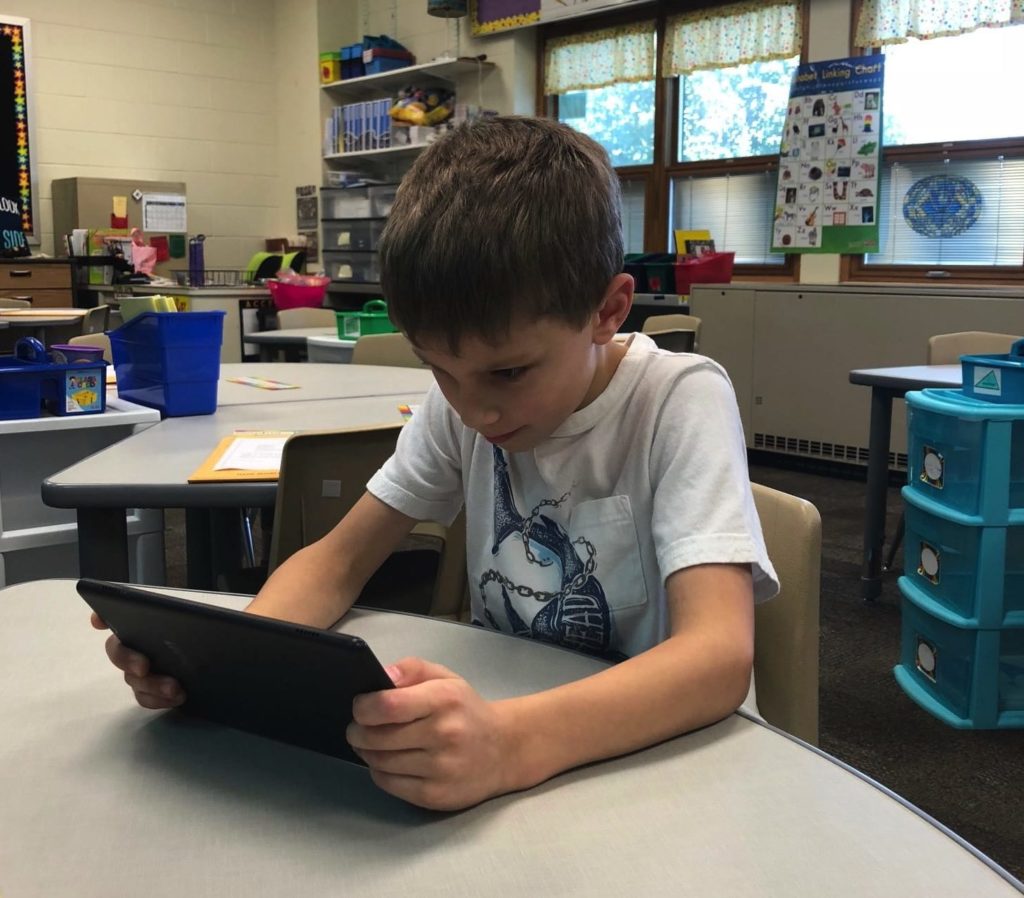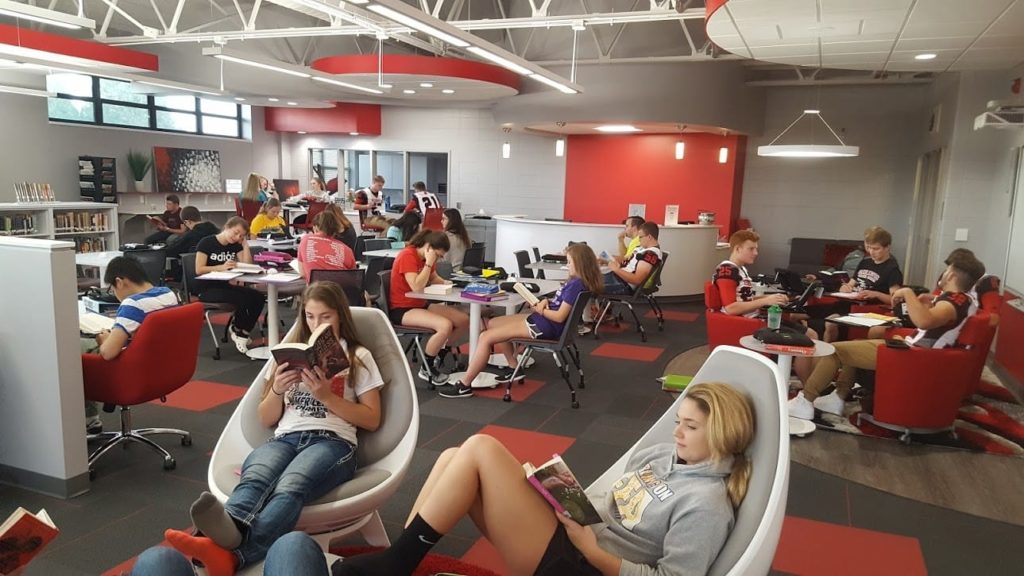The tide of teamwork between education and businesses is rising and that’s good news! The key components of 21st century learning environments — adaptability, flexibility, and the promotion of learner-focused integrated and collaborative activities — are the same elements that are important to thriving local businesses and communities. While that’s good news, it makes collaboration with a community’s educational leaders imperative.
The increase in technology combined with the focus on collaboration and flexible learning environments has affected the way we use space and furniture.
Education is Changing
Adjustments to educational delivery are being made because of the growing understanding of the ways that today’s students learn. They are digital natives that don’t blink an eye at the use of technology — you just have to watch the way a two-year old operates an iPad to realize the truth of that statement. Many elementary students are extremely comfortable and competent with computers, tablets, smart phones, and smart boards. Thanks to technology, students aren’t restricted to learning within the confines of a traditional classroom…they can learn anywhere, anytime, and often in a way that best fits their learning styles.
The pioneering environments that support 21st century learning are flexible, versatile, tech-infused spaces that are catalysts for teachers to provide groundbreaking approaches to education. But it’s not just the educational environment that is changing.

Work Environments are Shifting
Can you think of a career that isn’t more integrated now with technology than just a few years ago? Most jobs rely heavily on technology, some careers are absolutely dependent upon it, and others are simply enhanced because of it. Gallup reports that 43% of today’s employees telecommute at least some of the time, with nearly all of them utilizing technology to stay connected. In addition, manufacturing, healthcare, and financial sector jobs increasingly rely on information and collaboration technology.
The stronger encouragement of collaboration and teamwork in today’s workplace is fueled by technology.
Communities are Hungry
Twenty-first century learning focuses on the 4 “C’s” – Communication, Collaboration, Critical Thinking, and Creativity. These same principles align with the educational mindset of our communities today. We must be certain that we’re responding to current research, while also being attuned to the world around us.
We must be mindful of what factors are changing in our local community.
The options and opportunities we provide to students and the emergence of fresh approaches to learning must be based on technology, new research regarding the human brain, and a more collaborative and student-led approach to education. We must be mindful of what factors are changing in our local community. Are community leaders focusing on attracting a specific type of industry? Is a unique trade or business sector expanding swiftly in the region? Are there skillset deficits in the area? It is vital for business, community, and educational leaders to be engaged with one another.
This teamwork will guarantee that the needs of the area’s workforce are appropriately aligned with accessible educational programs and skills training. In many communities there is a chasm between the anticipated workforce needs of the future and the anticipated knowledge and skill level of students. Are we equipping (and establishing the vision) for students to obtain four-year or associates degrees, or applicable trade certifications when they graduate? Are we working in partnership with businesses, chambers, educational foundations, colleges, universities, and concerned citizens? Are we creating new programs, facilities, and even events that will assist our students and their families to ensure local, regional, and national workforce needs are properly aligned with our skills training and educational programs?
Innovation Demands Flexibility
The increase in technology combined with the focus on collaboration and flexible learning environments has affected the way we use space and furniture. It is no longer essential we sit at a desk in order to learn. Comfortable chairs, or even bean bags, are often preferred for reading or working on a tablet or laptop and can easily be moved to accommodate the moment.
Innovative learning environments can be created quite cost effectively through thoughtful analysis of how each space will be utilized. The primary function of libraries is no longer to provide references, resources, and reading materials. To remain germane, libraries are increasingly shifting their focus away from paper books and moving towards e-learning and collaboration. To be conducive to project-based learning, they often come complete with rooms designed for teams of varying sizes. Less dependence on books diminishes the need for space-taking bookshelves. Since walls no longer need to be lined with such casework, the space can take advantage of natural lighting and be equipped with movable and writable or tackable surfaces used for outlining projects, as well as thoughtful collaboration.

Science labs of years gone by consisted of fixed lab tables, often laid out in islands with a separate area for desks. A more flexible solution is to arrange all the casework along the walls, including stations with sinks and gas hook-ups. Adjustable height tables can be wheeled to the stations for lab experiments or arranged in various shapes in the center of the room for lectures, discussions, and other learning activities. Due to these flexible options, learning spaces are configured and easily reconfigured to better support the needs of the students and the learning environment.
A Fine Example
In collaboration with the community, the Berlin Area School District in Berlin, Wisconsin, passed a successful referendum by a margin of three-to-one. The referendum funded an expansion of the elementary school, renovations to the high school, as well as construction of a new middle school. The 21st century learning environment that was proposed for the renovation and new construction was key to the excitement the community demonstrated for the project.
One aspect to focus on that is certain to be a hit with your constituents, is to increasingly emphasize STEM (science, technology, engineering and math) curricula. Learning environments with a STEM, or STEAM (adding the arts), focus prepares students to not only survive but thrive in the burgeoning technology and science careers of tomorrow.
Anticipate the Benefits
With a forward-thinking mindset and sustainable community-based partnerships, positive outcomes can be realized.
Here is a sampling of the benefits you can anticipate:
- Increased staff retention
- Improved staff morale
- Greater ability to recruit top talent
- Enhanced student morale and participation
- Faster student advancement
- A more positive brand and reputation
- Additional school revenue due to positive open enrollment
- Increased community confidence
- More substantial donations
- Inventive partnerships
It is common for those who are considering relocating to a new community to check the quality of the schools. The quality of the school district plays an essential role in the economic well-being of our communities.
Raising the Bar
When we provide a true 21st century education, which is aligned to the future workforce needs of our area, our communities succeed. Then, we attract more residents, raising our enrollment…and the snowball rolls in the right direction.

